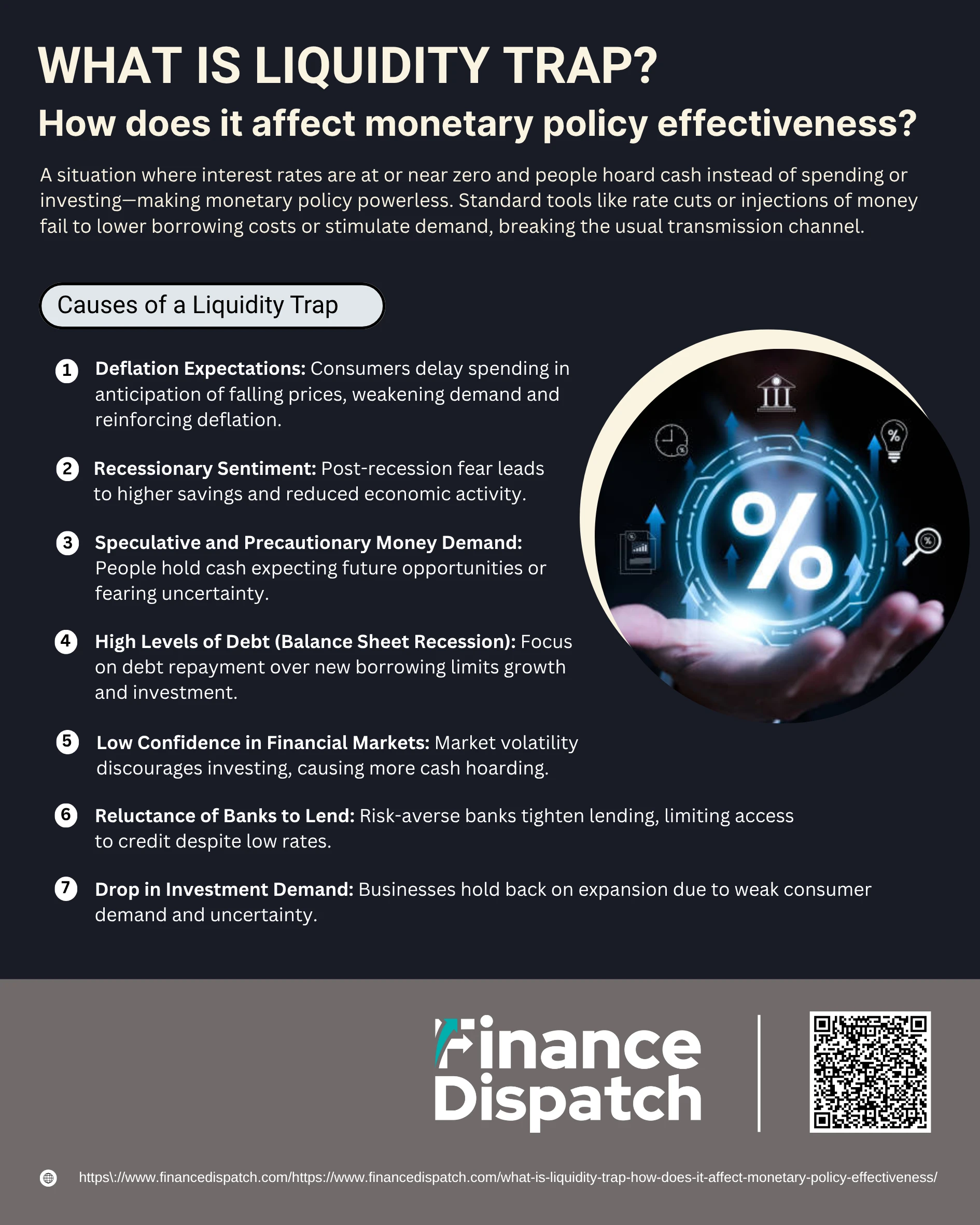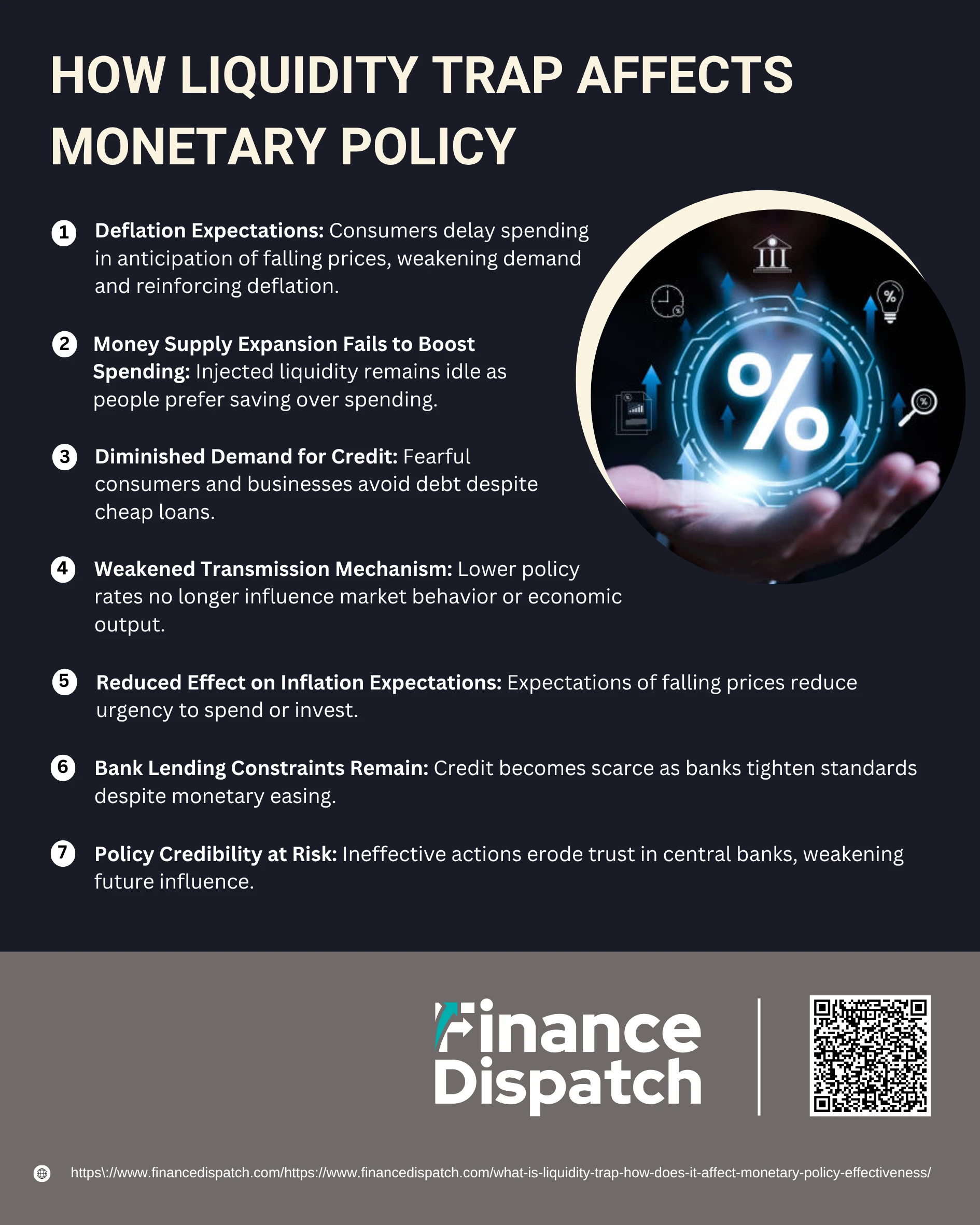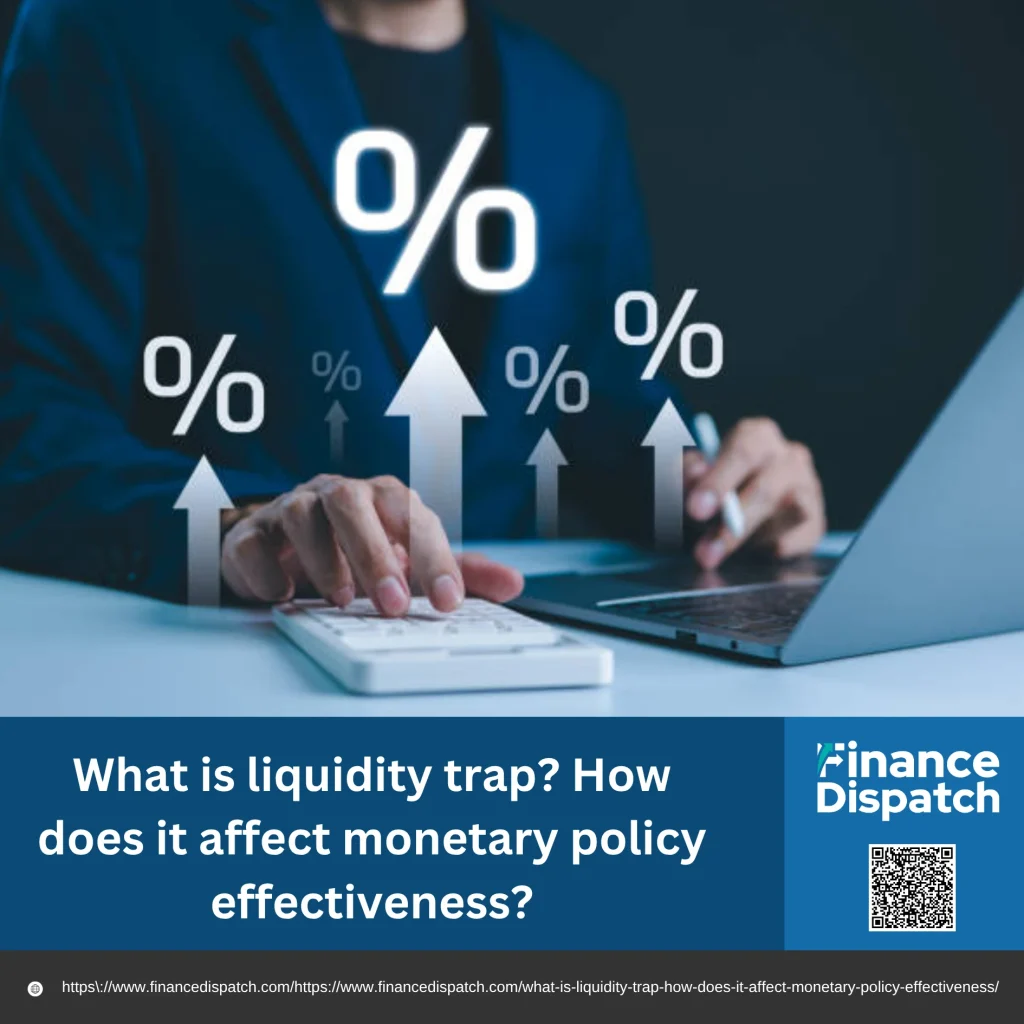In times of economic downturn, central banks typically rely on monetary policy tools—like cutting interest rates or increasing the money supply—to stimulate growth. However, what happens when these tools stop working, even when interest rates are at or near zero? This perplexing scenario is known as a liquidity trap. First introduced by economist John Maynard Keynes, the liquidity trap describes a situation where people and businesses hoard cash rather than spend or invest, despite low borrowing costs. This behavior renders traditional monetary interventions ineffective, stalling economic recovery and challenging policymakers. In this article, we’ll explore what a liquidity trap is, why it occurs, and how it severely limits the effectiveness of monetary policy in reviving economic activity.
What is a Liquidity Trap?
A liquidity trap is a rare and challenging economic condition in which interest rates are extremely low—often near or at zero—but people and businesses still choose to save rather than spend or invest. Despite the availability of cheap credit, there’s a widespread preference for holding cash due to fears of deflation, economic uncertainty, or expectations of rising interest rates in the future. This unusual behavior undermines the traditional role of monetary policy, which typically aims to boost economic activity by making borrowing more attractive. In a liquidity trap, even when central banks inject more money into the economy, the added liquidity remains idle, stashed in savings rather than circulating through consumption or investment. As a result, growth stagnates, inflation remains low or turns negative, and policy efforts lose their intended impact.
Key Characteristics of a Liquidity Trap
A liquidity trap presents a paradoxical scenario where traditional economic logic breaks down. Despite extremely low interest rates and efforts by central banks to encourage borrowing and spending, individuals and businesses remain hesitant to invest or consume. Instead, they choose to hold onto cash, reflecting a deep lack of confidence in the economy. This unusual behavior leads to several distinct features that mark the presence of a liquidity trap.
1. Near-zero or zero interest rates: Central banks lower rates to stimulate borrowing, but further cuts become impossible once rates approach zero.
2. High levels of savings: Consumers and investors prioritize saving over spending, even when saving yields little to no return.
3. Weak demand for loans: Despite low borrowing costs, there is minimal interest in taking on new debt due to pessimism about future economic prospects.
4. Cash hoarding behavior: Individuals and businesses prefer to hold liquid assets rather than risk investing in uncertain markets.
5. Ineffectiveness of monetary policy: Traditional tools like interest rate cuts or money supply expansion fail to stimulate economic activity.
6. Low inflation or deflation: Prices either remain flat or fall, reinforcing expectations that future purchases will be cheaper, which further delays spending.
7. Stagnant economic growth: Overall demand stays weak, leading to underutilized resources, low investment, and prolonged recessionary conditions.
 Causes of a Liquidity Trap
Causes of a Liquidity Trap
A liquidity trap emerges from a complex interplay of psychological, financial, and structural factors that disrupt the normal functioning of an economy. While monetary policy is designed to encourage borrowing, spending, and investment during slowdowns, certain conditions can lead people and institutions to act counterintuitively—by clinging to cash and avoiding financial risk. These behaviors are often rooted in fear, uncertainty, or strategic delay, and they collectively contribute to the breakdown of traditional economic stimulus tools. Below are the key reasons a liquidity trap may occur:
1. Deflation Expectations
When people believe that prices will continue to fall, they often postpone purchases and investments. For instance, if a car or home is expected to be cheaper in six months, consumers are less likely to buy now. This delay in spending reduces overall demand, worsens deflation, and makes it harder for central banks to influence economic behavior through interest rate cuts.
2. Recessionary Sentiment
In the aftermath of a recession, economic agents often become risk-averse. With memories of job losses, pay cuts, and market crashes fresh in their minds, both consumers and businesses prioritize saving and debt repayment over new expenditures. This results in a widespread withdrawal from economic activity, reinforcing stagnation.
3. Speculative and Precautionary Money Demand
People may choose to hold cash either as a safety net for future uncertainties (precautionary) or because they expect to take advantage of future investment opportunities (speculative). For example, an investor may avoid buying bonds now if they expect interest rates to rise later, which would push bond prices down. Both motives lead to a preference for liquidity, reducing the velocity of money in the economy.
4. High Levels of Debt (Balance Sheet Recession)
In situations where debt levels are high, consumers and firms focus on reducing liabilities rather than acquiring new ones—even if borrowing costs are low. This process of deleveraging suppresses new lending, investment, and consumption, leading to reduced economic activity and making monetary policy less effective.
5. Low Confidence in Financial Markets
During volatile or uncertain periods, investors shy away from putting money into stocks, bonds, or other instruments. This lack of demand drives down asset prices and further discourages participation in the financial markets. Instead of investing, people hoard cash, waiting for greater stability or better returns.
6. Reluctance of Banks to Lend
If financial institutions are worried about rising default risks or weak economic outlooks, they may become stricter in their lending practices. Even with near-zero interest rates, borrowers—especially those with weaker credit profiles—may find it difficult to secure loans, stalling credit flow and economic recovery.
7. Drop in Investment Demand
In a sluggish economy, businesses often see little justification for expanding operations or upgrading infrastructure. Weak consumer demand and uncertainty about future profits discourage firms from seeking loans, no matter how favorable the interest rates are. This limits the stimulative impact of monetary easing.
 How Liquidity Trap Affects Monetary Policy
How Liquidity Trap Affects Monetary Policy
Monetary policy plays a key role in managing economic cycles—stimulating growth during recessions and cooling inflation during booms. The central bank typically influences the economy by adjusting interest rates and controlling the money supply. However, in a liquidity trap, these levers lose their potency. Even when interest rates are cut to zero and banks are flooded with liquidity, businesses and consumers may still refuse to borrow, spend, or invest. This disconnect between policy action and economic response undermines the entire mechanism of monetary stimulus. Below are the key ways in which a liquidity trap cripples the effectiveness of monetary policy:
1. Interest Rate Cuts Become Powerless
Central banks usually reduce interest rates to stimulate borrowing and investment. But in a liquidity trap, rates are already at or near zero—the “zero lower bound.” At this point, further cuts offer no additional incentive for borrowing. Since rates can’t go below zero easily (without entering negative territory), the central bank is left without its primary tool to revive demand.
2. Money Supply Expansion Fails to Boost Spending
An increase in the money supply is intended to encourage lending by banks and consumption by households. However, during a liquidity trap, this strategy fails because people and institutions prefer to hold cash. They see holding onto money as safer than spending or investing it, especially when confidence in the economy is low. This results in “idle liquidity” that does not circulate back into the economy.
3. Diminished Demand for Credit
Even with low interest rates and increased bank reserves, businesses and households may be unwilling to borrow. Fear of future income loss, declining profits, or economic instability leads them to avoid new debt. Instead of expansion, they prioritize savings or paying down existing obligations—reducing the stimulative effect of easier credit conditions.
4. Weakened Transmission Mechanism
Under normal conditions, changes in the central bank’s policy rate influence other interest rates (like mortgage and business loan rates), which then influence spending and investment. In a liquidity trap, this chain breaks down. Lower rates do not translate into increased borrowing or investment, meaning monetary policy has a weak or negligible effect on economic output.
5. Reduced Effect on Inflation Expectations
One of the goals of monetary stimulus is to boost inflation expectations. When people expect prices to rise in the future, they are more likely to spend now. However, in a liquidity trap, deflation—or the expectation of falling prices—takes hold. Consumers delay purchases and businesses delay investment, expecting better deals later. This reinforces low demand and further undermines policy efforts.
6. Bank Lending Constraints Remain
Liquidity traps are often accompanied by heightened financial risk and uncertainty. Banks, fearing defaults, tighten their lending standards. Even if interest rates are low, banks may be reluctant to lend unless borrowers are exceptionally creditworthy. This restricts credit availability, especially for small businesses or individuals, and hampers the central bank’s ability to stimulate the economy through lending.
7. Policy Credibility at Risk
If monetary policy fails to produce visible improvements in economic conditions, public and market confidence in the central bank may erode. This loss of credibility can be damaging in the long run, as future policies may be ignored or doubted. A central bank that appears ineffective may struggle to guide expectations—a crucial component of modern monetary policy.
Monetary Policy Tools and Their Limitations
In normal economic conditions, central banks rely on a set of core tools to manage inflation, encourage investment, and stimulate growth. These tools—such as adjusting interest rates, conducting open market operations, and modifying reserve requirements—are typically effective in influencing borrowing, spending, and liquidity in the economy. However, during a liquidity trap, these traditional instruments lose much of their impact. The expected reactions from households and businesses often do not materialize, rendering monetary policy less useful. The table below outlines the major tools of monetary policy and explains why they become limited in a liquidity trap:
| Monetary Policy Tool | Purpose | Limitation in a Liquidity Trap |
| Interest Rate Cuts | Lower borrowing costs to encourage loans and spending | Rates are already at or near zero; further cuts have little to no additional effect |
| Open Market Operations (OMO) | Buy/sell government bonds to influence liquidity and interest rates | Investors may sell bonds eagerly, but added liquidity is hoarded rather than spent |
| Reserve Requirement Adjustment | Free up funds for banks to lend more | Banks may still refuse to lend due to credit risk or low demand from borrowers |
| Quantitative Easing (QE) | Purchase long-term assets to inject liquidity and lower long-term rates | Money injected often stays within the banking system and doesn’t translate into real economic activity |
| Forward Guidance | Shape expectations by committing to future policy paths | May lack credibility if the public loses trust or continues to expect poor economic performance |
| Negative Interest Rates | Penalize holding excess reserves to encourage lending | Banks and savers may still hoard cash or pass costs onto customers without increasing spending |
Real-World Examples of Liquidity Traps
While the liquidity trap is a theoretical concept in economics, history has shown several real-world instances where it unfolded with serious consequences. These examples reveal how conventional monetary policies became ineffective, and how economies struggled to recover despite near-zero interest rates and aggressive central bank actions. Each case provides valuable insight into how consumer psychology, deflationary pressures, and institutional behaviors can stall growth—even when money is readily available.
1. Japan’s Lost Decade (1990s–2000s)
After a major asset bubble burst in the late 1980s, Japan experienced prolonged economic stagnation. Despite cutting interest rates to zero and implementing quantitative easing, consumer demand and investment remained weak for decades. Deflation and an aging population further complicated recovery efforts.
2. The Great Depression (1930s, USA)
During the early 1930s, U.S. interest rates fell dramatically, but confidence collapsed, and people hoarded money. The Federal Reserve’s traditional monetary tools failed to revive demand, prompting the government to adopt large-scale fiscal measures like the New Deal to stimulate the economy.
3. Global Financial Crisis (2008–2010)
Following the collapse of major banks and housing markets, central banks in the U.S., UK, and Europe slashed interest rates and launched massive quantitative easing programs. Yet, demand stayed subdued for years as households paid down debt and banks tightened credit standards.
4. Eurozone Sovereign Debt Crisis (2010s)
Countries like Greece, Spain, and Italy faced stagnation despite low interest rates and bond-buying programs by the European Central Bank. Austerity measures and weak consumer confidence contributed to prolonged economic underperformance in the region.
5. COVID-19 Pandemic (2020–2021)
In response to global lockdowns and economic uncertainty, central banks worldwide reduced interest rates to near zero and injected liquidity through stimulus packages. Nevertheless, widespread fear and uncertainty led to increased saving and reduced spending, closely resembling a liquidity trap scenario.
Liquidity Trap Implications on Broader Economy
A liquidity trap poses significant risks to the overall health and stability of an economy. When consumers and businesses hoard cash despite low interest rates, the flow of money slows down, leading to reduced spending, investment, and production. This behavior weakens aggregate demand, causing a ripple effect across sectors—from lower corporate revenues and shrinking employment to stagnant wages and diminished consumer confidence. Financial markets suffer as well; bond prices drop due to lack of demand, and equity markets face volatility as investors remain cautious. Additionally, persistent deflation or near-zero inflation can erode business profits and discourage future investment. Over time, this economic paralysis can deepen a recession, prolong recovery, and limit the government’s ability to effectively respond using traditional monetary tools.
Strategies to Overcome a Liquidity Trap
Overcoming a liquidity trap requires more than just conventional monetary adjustments—it demands bold, coordinated actions that restore confidence, stimulate demand, and encourage spending and investment. Since traditional tools like lowering interest rates become ineffective, central banks and governments must turn to alternative approaches that address both the psychological and structural causes of economic stagnation. Below are some widely discussed and historically applied strategies to help an economy break free from a liquidity trap:
1. Expansionary Fiscal Policy
Governments can increase public spending on infrastructure, health, and education, or provide direct stimulus payments and tax cuts to boost disposable income and drive demand.
2. Quantitative Easing (QE)
Central banks purchase long-term securities to inject liquidity directly into financial markets, lowering long-term interest rates and encouraging lending and investment.
3. Negative Interest Rate Policy (NIRP)
By setting nominal interest rates below zero, central banks incentivize spending and discourage hoarding, although this approach carries risks for savers and banks.
4. Raising Inflation Expectations
Committing to higher future inflation targets can shift consumer behavior, encouraging current spending before prices rise, thereby boosting short-term demand.
5. Direct Monetary Transfers (“Helicopter Money”)
Governments or central banks may distribute money directly to households, bypassing traditional channels and ensuring the funds are used for consumption.
6. Currency Depreciation Policies
Weakening the domestic currency makes exports more competitive, potentially increasing external demand and supporting economic growth.
7. Financial Market Reforms and Innovation
Encouraging new investment opportunities, such as through startup incentives or technology funding, can draw idle cash back into productive use.
8. Restoring Consumer and Business Confidence
Transparent, credible policymaking and public-private partnerships can reduce uncertainty and foster a sense of economic stability, leading to more active financial participation.
Criticisms and Alternate Views of Liquidity Trap
While the liquidity trap is widely accepted in Keynesian economic theory, it has faced criticism from other schools of thought—particularly Austrian and monetarist economists. Critics argue that liquidity traps are not the result of market failures but rather the consequence of excessive government intervention or flawed central bank policies. For instance, followers of Ludwig von Mises contend that efforts to combat a liquidity trap, such as quantitative easing or negative interest rates, may actually distort market signals and weaken the economy’s foundation by encouraging unproductive behavior and undermining real savings. Monetarists, on the other hand, believe that better management of money supply—rather than fiscal stimulus—is sufficient to steer the economy out of stagnation. Some also challenge the idea that consumers and businesses act irrationally during downturns, suggesting that their preference for cash reflects rational responses to policy uncertainty and structural weaknesses. These alternative views highlight the ongoing debate about the true nature of liquidity traps and the best path toward sustainable recovery.
Conclusion
A liquidity trap represents one of the most complex and stubborn challenges in modern macroeconomics. When interest rates are near zero and traditional monetary tools lose their effectiveness, economies can slip into prolonged stagnation marked by weak demand, high savings, and low confidence. This phenomenon not only exposes the limitations of monetary policy but also underscores the importance of timely and coordinated fiscal action. While strategies like quantitative easing, fiscal stimulus, and inflation targeting offer potential solutions, their success ultimately depends on restoring public confidence and encouraging meaningful economic participation. Understanding the causes, consequences, and remedies of a liquidity trap is crucial for policymakers, economists, and citizens alike as they navigate the path toward recovery and long-term stability.



